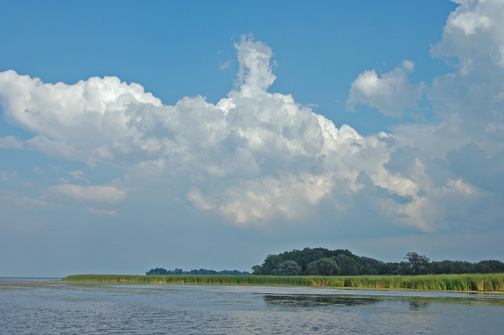Plans for Braddock Bay Restoration:
Greece, NY
Project Location: Braddock Bay is located on the shore of Lake Ontario within the Great Lakes Rochester Embayment Area of Concern (AoC) in the town of Greece in Monroe County, New York. Here is what the US Army Corps/Buffalo plans for the $9M in construction:
Project Description: Braddock Bay is a coastal freshwater ecosystem consisting of 340 acres of emergent and submerged wetland habitat. Shoreline development and management of Lake Ontario lake levels has been negatively impacted many of the process that maintained Braddock Bays diverse habitats. The project goal is restoration and protection of Braddock Bay’s coastal wetlands. The project will restore wetland habitat, treat invasive species, and improve the coastal resiliency of existing wetlands by restoring the historic barrier beach. Potential project alternatives involve restoration of an extensive network of channels and potholes that will increase habitat interspersion, complexity, and diversity; as well as restoration of the former barrier beach to protect the bay from wave energy and reduce erosion of existing wetlands.
Project Authorities: This project is being completed under the Economy Act. Through this authority, the U.S. Environmental Protection Agency has funded the U.S. Army Corps of Engineers to conduct a Feasibility Study, Design, and potentially project construction.
Non-Federal Partner: No cost share sponsor is required for the current design. Funding is provided by the Great Lakes Restoration Initiative (GLRI) through USEPA and is 100% Federal. Both the Town of Greece and New York State Department of Conservation support implementation.
EWN Application: Historically, strategies for reducing erosion involved construction of rock revetments or breakwaters that lacked the natural transitions from shallow water aquatic habitat to upland terrestrial. At Braddock Bay a stone breakwater is being augmented with features that will allow it to maintain a barrier beach mimicking the natural barrier beach that was historically present at this location. This barrier will reduce erosion and have the secondary benefit of restoring the natural littoral drift processes in the vicinity of the project. The natural littoral processes will move this littoral sediment along the restored barrier beach helping to nourish it while also increasing the amount of littoral sediments that move past Braddock Bay and into downdrift areas. The restored barrier beach will help return Braddock Bay to the low energy system it was historically. As a result, reductions in wetland erosion will be accompanied by natural expansion of submerged aquatic vegetation. A variety of wetland restoration measures will be implemented to further augment these benefits by increasing the diversity and extent of emergent wetland habitat and ultimately increase its suitability for wildlife.
Project Location: Braddock Bay is located on the shore of Lake Ontario within the Great Lakes Rochester Embayment Area of Concern (AoC) in the town of Greece in Monroe County, New York. Here is what the US Army Corps/Buffalo plans for the $9M in construction:
Project Description: Braddock Bay is a coastal freshwater ecosystem consisting of 340 acres of emergent and submerged wetland habitat. Shoreline development and management of Lake Ontario lake levels has been negatively impacted many of the process that maintained Braddock Bays diverse habitats. The project goal is restoration and protection of Braddock Bay’s coastal wetlands. The project will restore wetland habitat, treat invasive species, and improve the coastal resiliency of existing wetlands by restoring the historic barrier beach. Potential project alternatives involve restoration of an extensive network of channels and potholes that will increase habitat interspersion, complexity, and diversity; as well as restoration of the former barrier beach to protect the bay from wave energy and reduce erosion of existing wetlands.
Project Authorities: This project is being completed under the Economy Act. Through this authority, the U.S. Environmental Protection Agency has funded the U.S. Army Corps of Engineers to conduct a Feasibility Study, Design, and potentially project construction.
Non-Federal Partner: No cost share sponsor is required for the current design. Funding is provided by the Great Lakes Restoration Initiative (GLRI) through USEPA and is 100% Federal. Both the Town of Greece and New York State Department of Conservation support implementation.
EWN Application: Historically, strategies for reducing erosion involved construction of rock revetments or breakwaters that lacked the natural transitions from shallow water aquatic habitat to upland terrestrial. At Braddock Bay a stone breakwater is being augmented with features that will allow it to maintain a barrier beach mimicking the natural barrier beach that was historically present at this location. This barrier will reduce erosion and have the secondary benefit of restoring the natural littoral drift processes in the vicinity of the project. The natural littoral processes will move this littoral sediment along the restored barrier beach helping to nourish it while also increasing the amount of littoral sediments that move past Braddock Bay and into downdrift areas. The restored barrier beach will help return Braddock Bay to the low energy system it was historically. As a result, reductions in wetland erosion will be accompanied by natural expansion of submerged aquatic vegetation. A variety of wetland restoration measures will be implemented to further augment these benefits by increasing the diversity and extent of emergent wetland habitat and ultimately increase its suitability for wildlife.


No comments:
Post a Comment